#and art is inherently tied to creativity
Explore tagged Tumblr posts
Text
Maybe i'm just an artistic soul, but i truly do believe that art is what makes us human, what sets us apart from animals. Nothing more ingrained in our souls than creating, even if you don't consider yourself to have talent for art, you know you have created in your life. To devalue art is to devalue humanity.
#we are never beating the shu kinnie allegations are we#but idk what shu's opinion on what constitutes art is but#me i believe anything can be art#engineers and trades folks create just as much as writers and illustrators. creativity is more than just the recognised artforms#and art is inherently tied to creativity#i'm the exact opposite of people who try to push art in one definition#because to me everything can be art. anything can be art. because art is human and it's human to create art#just by being a human who made something with your own two hands - you can call it art#all it takes is creativity and will
15 notes
·
View notes
Text
Okay positive post:
The Everlux are super cool and I'm glad that the art team really stretched their wings and gave us a really interesting design. Sure, they're a little cluttered and the male pose nearly completely negates the secondary genes, but I think overall the design AND all the Everlux genes are home runs. It's probably one of the best releases, in my opinion.
I think it's great that they're really pushing what kind of dragons can exist in their world and really making it clear that shape and concept are not inherently tied to the Element the dragon originates from.
I hope that all the negativity does not cause the art team to pull back on pushing the envelope. We need more of this creativity, not less! Even if you don't like Everlux, I hope you'll understand how important it is, conceptually, for the team to make designs that aren't going to appeal to every single player -- even outside of the fact that you just can't please everyone no matter how hard you try.
The more variety in dragons, the cooler the site as a whole is. I hope that the team gives us even more weird dragons inspired by a wide variety of animals and insects. I hope the Wind Ancient is neat as fuck.
And I hope that Shadow can get a modern common breed. Please.
341 notes
·
View notes
Note
Hi Jonny, if you don't mind I have a question about the TMA TTRPG! So I noticed that on the player's guide there's this guy, who my friends and I assumed is probably Jon. If it is him, is this a canon design, or more like some of the non-canon stuff that's in the merch?
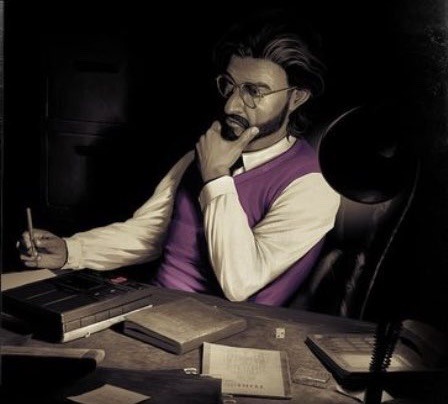
So, I hope you don't mind if i use this ask to go a bit off on one. I'm not specifically dragging you (I'm actualy glad you asked, as I've thinking about posting on the topic), but all the discussion around the RPG art and how "official" or "canon" it might be is, to my mind, slightly silly.
First up, is it "official" art? I mean, yeah, its art for the officially licenced Magnus Archives RPG. This means Monte Cook Games have commissioned someone to do a beatiful illustration broadly based on some aspect, episode or character from the podcast and it goes in the book. But that's kinda all it means. "Official" is a legal distinction, not an artistic one. The fact that it's in an official product doesn't make it any less one artist's cool interpretation of a character that has only been vaguely described in audio.
Second, is it Jonathan Sims the Archivist? I mean, it's probably based on the idea of him, but it's certainly not set in stone. When we were first discussing art with MCG, we advised that character pictures be more vibes-based and not explicitly tied to specific people (ie. a portrait inspired by Tim wouldn't be captioned "This is Tim" and wouldn't be placed opposite a profile for Tim Stoker, archival assistant.) This was mainly because we wanted the artists to have plenty of freedom to interpret and not feel too tied down by the need to know everything about the podcast. But, to be frank, it was also because we know that there are a few fans out there that are kinda Not Chill about what they've personally decided these characters look like and can get a bit defensive over depictions that differ.
It strikes me as particularly strange to be having this discussion about art that's for a roleplying game book. Something that's explicitly and solely designed to give you the ability to play in your version of the Magnus universe. The idea that this is the thing where we'd for some reason try to immutably establish unchangable appearances for these characters would be pretty funny if some folks weren't taking it so seriously. Similarly ridiculous is the idea we could reasonably have said to MCG "We'd love for you to make a huge beautiful RPG book of our setting... Just make sure you don't depict any of the iconic characters or events from it!"
But... is it "canon"? Now, to my mind, this highlights a real weakness in a lot of fandom thinking around "canon", which is that it generally has no idea what to do with adaptations. All adaptation is interpretation, and relies on taking a work and letting new creatives (and sometimes the same ones) have a different take on it. Are the appearances of the Fellowship of the Ring in the LOTR movies "canon"? How much, if at all, does that matter? Neil Gaiman's book Neverwhere was originaly a 90s BBC series made with a budget of 50 pence; is anyone who makes fanart of Mr Croup that doesn't look like the actor Hywel Bennet breaking canon? What about the novel that describes the character differently? Or the officially licenced Neverwhere comic where he looks like neither of them? Which is his "canon appearance"?
Canon is an inherently messy concept, and while it is useful for a creative team trying to keep continuity and consistency within a creative work, for thinking about anything beyond that it tends to be more hinderance than help.
Anyway, all this is to say that the above picture and all the others in the RPG are exactly as canon as every other picture you've ever seen of the Archivist.
3K notes
·
View notes
Text

someone needs to investigate the link between hentai and furry because from the furry art i sometimes see on this website, most seem to have pornbrain. they almost always have the same anime like drawing style, im always embarrassed they call themselves artists when there is nothing creative about that drawing style. im sure there are some furries who treat it like cosplay more than a sex thing but it very much is a sex thing. if you type in furry in tumblr search bar you will see kink shit within the first few posts, and of course enlarged breasts. furries do have a zoophilia and zoosadism problem in their community too, unsurprisingly. how many kids first introduction to kink is through furry stuff online? you take these characters appealing to kids, often even from kids shows, and sexualise them in the wildest ways possible. my first exposure to vore was through furry fetish „art“ on this website when i was a minor still.
none of this has anything to do with being same sex attracted. and i think most trans people would also be offended to be compared to people who have a fetish for (cartoon) animals. and „dressing weird“ and „looking different“ are not inherently lgb characterisitics.
this is why i hate the term „queer“. to me its not a slur because im german and we have no equivalent (to my knowledge), the literal english term was introduced here as an umbrella term - we even have a „queer beauftrage“ („queer deputy“) in the national government. „queer“ is always associated with lgb and now trans people (who are already two different groups with divergent interests and the only reason we‘re historically tied is because transvestites used to be homosexual). now all sorts of kinksters and „sexual minorities“ attach themselves to this. we already have an issue with how bold both bdsm and pedophilia groups are in germany. they love that „queer“ is associated with gays and lesbians and their valid advocacy for same rights, same sex marriage, and so on, which gives legitimacy to the tqa++* since gay and lesbian acceptance has increased since the 2010s (and now back to decreasing because of gender nonsense and worse, these other groups), while at the same time not meaning same sex attracted which allows anyone considering themselves a „sexual minority“ - such as furries - to call themselves „queer“, leeching of the legitimacy of the gay rights movement while at the same time undoing progress of the movement by branding same sex attracted people „queer“, weird, different, basically the same as having a fetish. fuck off!
90 notes
·
View notes
Text
I was asked by several people to elaborate on why I thought people hated Essek and specifically treated him as some spontaneous disruption rather than a choice driven by cast members, and so here it is.
An overarching theme is this: Matt, the creator of Exandria and DM for Critical Role, created Essek. The entire cast of Critical Role likes him. Liam O'Brien, as Caleb, chose to romance him. Now, none of this prevents you from disliking him, but I think people pile their hate on Essek because they don't want to admit they are upset with choices the cast members have made. (For what it's worth, this is why I think it's healthy to be able to express that you are frustrated with a cast member's character choices or with developments in the campaign or creative choices generally, and treating expressions of dislike as taboo or worse, inherently problematic, ultimately makes for a far more toxic fandom than one in which people can comfortably say "I don't like this"). Essek is an NPC, and as the post that led me to write this up states, he is a character who represents Matt's narrative decisions and the cast's choices in Campaign 2. To be mad at him is to be mad at a puppet because for whatever reason you are unwilling to admit a dislike for what the puppeteer is doing.
Now: why Essek specifically?
People who shipped Caleb with Jester do this a lot. I'll admit to my own biases re the C2 ships but I do reject this being pure fanwank because people who shipped other Caleb ships and were still around in the late campaign either mostly acted like adults, or just kind of threw Essek into the mix. The thing really is that a lot of people who shipped Caleb and Jester are very big fans of Liam specifically, and Liam and Laura's dynamic, and are loathe to say that Liam decided not to have Caleb significantly pursue the relationship; that Laura chose to have Jester act utterly unaware of the relationship; and that Liam decided, instead of having Caleb pine endlessly, to pursue another potential romantic interest. I also suspect that some abuse of power in specific fandom spaces gave people false hope and inflamed resentment. A lot of these people also hate on Fjord but tend to be quieter about that because it's harder to pretend a PC isn't deeply tied to a cast member.
There is a subset of fans who treat mlm ships and wlw ships (or male and female characters) as locked in some kind of zero sum game in which the existence of one dims the light of the other. This is preposterous. I cannot imagine a more wretched and unhappy fandom experience than miserably tallying up fics and art and judging success not by quality and enjoyment of what content there is but rather whether there's more for your ship or more for other ships. I have joked that when my favorite character is popular I enjoy that they're popular, and when they're not, I enjoy that I clearly have refined and superior taste and I recommend others adopt this mentality. I also have half-joked that it would be fascinating to do a survey tallying the quantity of posts complaining about, say, Caleb and Essek's relationship someone has made, vs. how many posts they've made about (for example) Beau and Yasha's relationship, because a lot of the time the energy spent complaining, or worse, harassing others over their preferences could have addressed the problem had it instead been devoted to creating fanworks for your ship of choice.
Also very generally, while it's true that there's no shortage of annoying fans of Essek, I promise, there's no shortage of annoying and shitty fans of basically every character and ship including the ones you like.
For his appearance in Campaign 3 specifically, I think people are blaming Essek for the fact that this is the Chickens Coming Home to Roost, Avengers Assemble campaign. If you take issue with the characters of Bells Hells being overshadowed by those from past campaigns, the time to make that complaint was when Laudna and Orym showed up as PCs with strong ties to Delilah and Keyleth, or at the very least when Keyleth was brought in as a ringer to help resurrect Laudna (and, as someone who did make those complaints at the time and has since accepted this is the Past Campaigns Campaign...this has not been the case). Multiple party members (as played by cast members) expressed interest and excitement in Aeor before Essek (even as Seth) was mentioned. Bells Hells (as played by the Critical Role cast) want to go to Aeor. You do not have to like it, but this is not Essek's fault, as he is an NPC as part of the story driven by the cast's choices.
I've said this before but it bears nonstop repeating: when the CR cast says it's their table, it does not mean "it's their table and above criticism." It means "they are making the choices they make to play a game that they will enjoy." You can and should say that you're not enjoying it. It won't change what they do, but you'll feel better. But Essek isn't a real person with real agency. If his appearance is upsetting you, you need to attribute that to Matt's choices and decide if this campaign is still something you wish to watch and if this fandom is still something in which you wish to participate. Acting like Essek is some kind of horrible natural disaster ruining your lovely picnic and not a very deliberate choice by Matt is a transparently absurd denial of reality.
88 notes
·
View notes
Note
not a question but basically any time i remember your art exists im looking it up and down and trying to take inspiration from it. your expression work is always top notch, and the way you depict faces is the perfect balance between cartoony and well defined
oh my god this is such an amazing compliment! thank you so much!
you know, i think this has been a long time coming. im going to take this as a chance to go in depth about how my style works, why i do what i do and how i do it. do keep in mind that none of this is me saying "this is the objectively correct way of doing art" but rather just how my own process works, what I like to see in my own art.
that balance that you speak of comes from a commitment to underlying structures. what im going to call the stylization sandwich
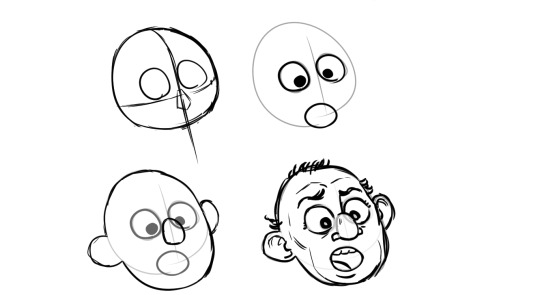
i start with a clear, well defined solid structure, i add whatever wacky cartoony features i want on top of it (none the less strongly tied and guided by the underlying structure) and then i refine by adding as many more realistic, grounding details i want, although you can go too far with it so i gotta be careful or ill end up with those shitty "cartoon character IRL would look scary!" clickbait drawings.

(quick aside, this trend fucking sucks, its obvious the artist went out of their way to make the drawing creepy, this pretension that "actually the character would look scary irl" deliberatly misundertands the principles of stylization, its as creatively bankrupt as jokes about mario eating mushrooms)
getting back on topic, the point is that, as long as the underlying structures are solid you can build whatever you want on top of them and it will make sense

a key tool here is internalizing the way the proportions on the face work. and i say internalize because obviously i dont actually have the golden ratio memorized inside my head nor do i stop and measure and calculate all the proportions in the features. i just read a lot about drawing, i drew a lot, i tried to always keep a critical eye to what im drawing and see if it "feels" disproportionate. once you get an eye for it then you know how far you can push things before they complitely break
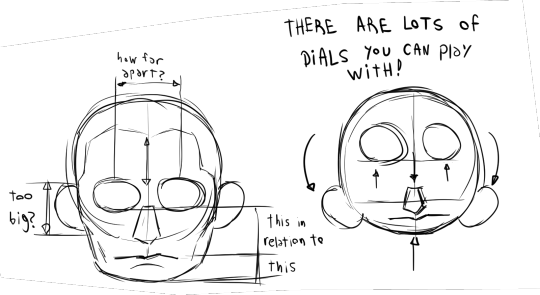
let me give you another example of what i feel is a botched execution of this.

if you look closely at the face on the left there are a lot of things that dont make sense. the corners of the eyebrows dip down into the eyes when usually the eyes are enveloped by the eyebrows, the way the beard grows around the nose is just not how facial hair is distributed, the mouth is too big, etc. on the left i used photoshop to reorganize the factions into something that makes a bit more sense to me
(another quick aside, the real big problem at the heart of the original drawing were not so much the proportions but the tangents, when different lines touch each other like this that is usually a big no no but that is a topic for another day)
also a lot of it is just me cheating. yeah i cheat. you ever heard how people say there is no innate talent and its all practisce and hard work. well, yeah, that is mostly true, but is also true that some people are born with inherent advantages. either taller or more predisposed to being thin or with better facial structures or better innate hand-eye coordination. i was born with an uncanny capacity to visualize stuff. i have whatever the opposite of aphantasia is. i can borderline hallucinate things if i want to. and that goes coupled with the visual intuitions i developed through practisce and training.
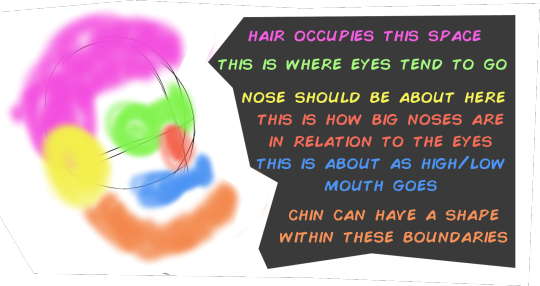
so first come the learned wisdom, and then comes the innate talent that helps me exploit that learned wisdom to its full potential
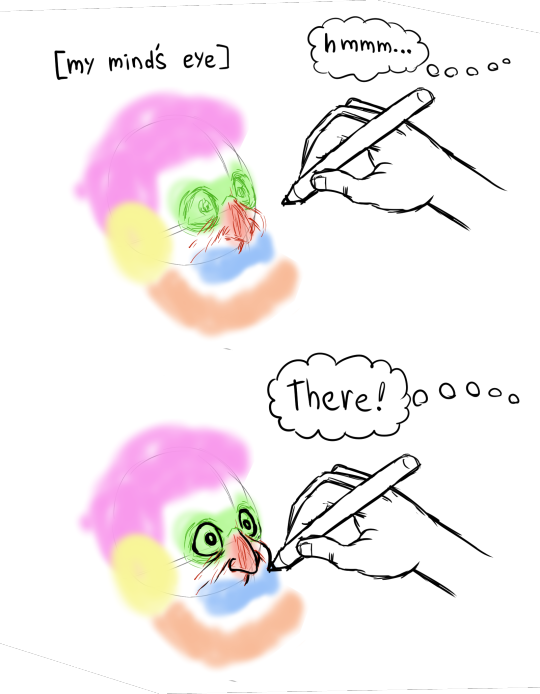
on top of that is corporeality, i try to draw in such a way that it conveys depth and weight to the things im drawing, certain kinds of stylizations dont care about that and choose instead to have their drawing look flat, a classic one is the UPA style

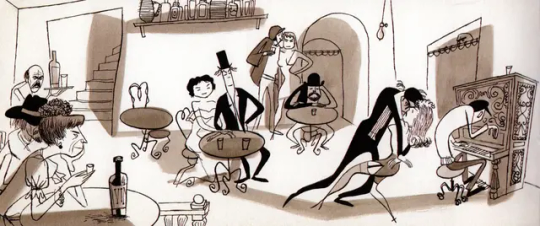

is a very fun style! very cute, very dynamic, very expressive in its simplicity. it became very popular in the 60's and 70's. personally i choose to go in a different direction. i draw in such a way that if one were to turn my drawings into 3d models not a lot would get lost in the process.
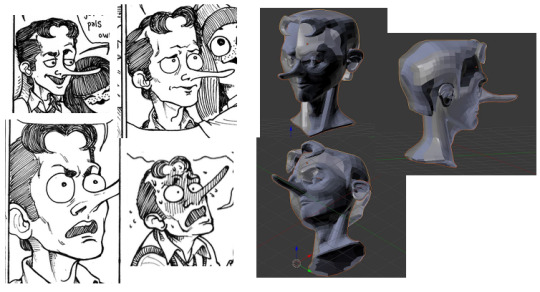
whereas other artists....

...not so much
but yeah, ultimatly it all goes back to underlying structure. any drawing can work
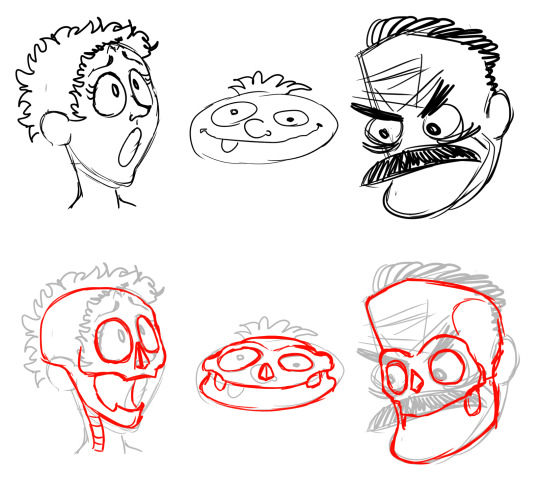
as long as you have a strong foundation underneath.
PS: if you like my style i cannot reccomend enough the art of @rezuaq i feel they follow a lot of the same principles i talked about here but i could be wrong.

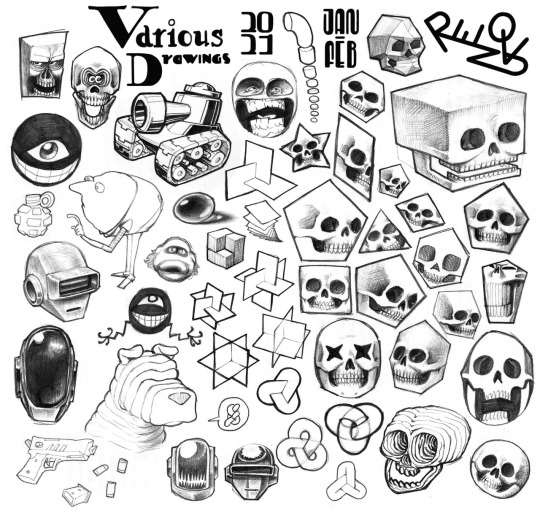
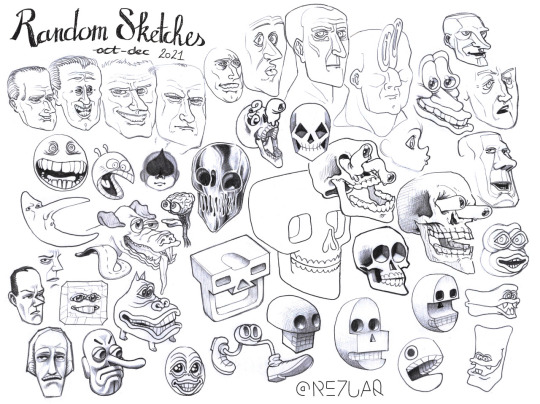
they have been my biggest inspiration as of the last 4 years, i shamelssly stole the design of one of their characters for jennyffer. go to their blog and give them a like
63 notes
·
View notes
Text
I've been a part of the phandom since I was fourteen back in 2012, but i've only recently deviated from my lurker ways and started being active in this community on tumblr. which I have been enjoying immensely! I'm super confused about something however, and so i'm making a post about it. please help.
often when I see the word "parasocial" used among the dnp audience, I've noticed that it's used with really negative connotations. Or with the implication that having a parasocial relationship is inherently bad and terrible. today, for instance, I've seen the term parasocial likened directly to "creepy."
I'd like to ask why that is-what has led to the perception of a parasocial relationship in this fandom as one that is intrinsically invasive and creepy. And I'd like also to put forth my own thoughts on why I think it's unhelpful and incorrect that we use this term to be a near synonym for creepy.
first, a definition. I'm turning to Hank Green for this, as he succinctly sums up what a parasocial relationship is in this vlogbrothers video (a recommended watch). He says a parasocial relationship forms "when the parts of your brain that are designed to have a social relationship between you and another person are used to have a relationship with a person who does not know who you are or, sometimes, cannot know who you are... because they're Huckleberry Finn."
At its most basic, a parasocial relationship is a relationship between you and someone fictional or nonfictional who doesn't know who you are. Hank goes on to say, importantly! that parasocial relationships have been happening since the beginning of time. People have been fans of famous or talented people since time immemorial, people have cared for fictional people since the first stories were told among humans.
~ ✌🏻continued below✌🏻 ~
Similarly, in one of his Am I The Hole videos, Phil says that becoming obsessed with things is normal. "People hyperfixate on stuff. It's fine." We all do it.
In many ways, parasocial relationships are as natural as myriad other forms of human bonds. Humans can't help but connect to each other. To other living and even non-living things. Bonding and connecting and forming communities is what we do. And because of that, I think it's a disservice to oneself be ashamed of being in a parasocial relationship, or to use parasocial as a term to serve as a stand in for a disrespectful fan of someone. I think it fosters a sense of guilt where there shouldn't necessarily be any, especially if you as a viewer of Dan and Phil are respecting the boundaries they have set. You are doing something so normal! So human! You are finding support and comfort and empowerment and motivation and creativity and any number of other things from other people.
There is great joy and great good that can come from parasocial relationships. Obviously! Think of Phil's birthday stream, the feelings you experienced when the lights came on in the theater after TATINOF, all the laughs (among other things) Dan and Phil have gotten from our memes and art.
And it's important to consider the other side of this as well. Dan and Phil also have a parasocial relationship with us. It's different, of course, but they do think of us, make decisions because of us, without truly knowing us. At different points in time maybe they know the loudest of us, a few individuals, but for the most part they do not know who we are. They don't know who you are. But they do think about you. They think about what ties us together, our queerness, our beliefs about the world, the internet, our status as socially awkward and or mentally ill nerds etc. They think about how certain videos or projects or merch will be received. All creators are in a relationship with their audience. And it is often a parasocial one.
Basically i find myself exasperated with stumbling over the word 'parasocial' in this fandom. I want to have the information and know the truth and add my own thoughts! Maybe parasocial is used by other people elsewhere on the internet to mean something bad, but my thesis is this: it's not a bad word. It's a descriptor. And it's a normal thing. Those people are wrong. You shouldn't feel bad about being in a parasocial relationship with Dan and Phil! You should call that relationship what it is with pride! And do as much good with it as you can.
conclusion: talk to me about this! What is your perspective, what am I missing? let me know please. would be happy to talk about this with anyone.
(ok what do i do now do i thank you for reading? i don't do this. text post over.)
60 notes
·
View notes
Text
I think fic writing is a storytelling experience you can’t get through selling (or trying to sell) your work.
Like, when I listen to people in my novel-writing course talk about certain obstacles they’re grappling with, I understand in theory.
“I wish someone would read my work and tell me I’m doing all right. I feel so isolated writing thousands of words alone.”
“I just don’t know what I’m doing right. I have no confidence in my writing because no one’s ever told me it’s good. I’m just hoping it is.”
“My dream is to hear someone tell me my book made them cry or laugh out loud.”
Like! Okay, right—
So much of storytelling is inherently tied to community. We tell stories to pass information, sustain culture, teach the next generation. Storytelling is hard to do in isolation because it’s not meant to be done in isolation.
And of course writing is even harder to do in isolation, because it involves learned skills like grammar and syntax and colloquialisms and analogies and narrative structure and all that important garbage. It involves creativity and logic and editing and blah blah blah. It’s hard.
But what makes fic writing different and fun is what’s made storytelling such a lasting and beloved pastime: community. We watch a show or a movie, read a book, listen to a podcast, what have you, and then we act on a tradition humans have been practicing for millennia: carrying those stories forward. Adjusting them, reshaping them, adding onto them. Fic writing is what happens when capitalists try to restrict what humans have always done with stories.
Why do it for free? Because we’re looking for community. Telling each other stories is how we connect, how we make sense of love and devastation and fear and awe. That’s why fic writers beg for comments and feedback. By posting fics, writers are basically throwing a hand up for a high five. We’re turning to readers and saying, “Can you imagine if ___?” We’re calling out into the dark hoping someone will answer.
The reason I’m still writing today is because I’ve spent most of my life in fic-writing communities. Strangers told a nine-year-old posting structurally terrible stories on FanFiction.net that they had a great time reading, and then that nine-year-old felt validated and excited to try again. People told that nine-year-old what parts they liked best, so that nine-year-old thought, “Oh,” and leaned into those parts.
Writing fic is safe and joyous for me because community after community sat around a bonfire with me and told me they enjoyed the stories I told them. Some of my fics have been translated into other languages and carried onto to new communities, some have been made into art and transformed into a different medium, and some have been read aloud and recorded. It’s all beautifully, magnificently centered around community.
And I wish more writers creating original work could experience this, because while there are always going to be conflicts wherever there are people, humans make the experience of living warmest when we build and maintain communities. When we tell each other stories for the simple satisfaction of knowing someone is smiling with anticipation as you start to tell them yours.
24 notes
·
View notes
Note
What’s your thoughts about gender in Transformers specifically because I really love your take on the characters
that’s a good question! I’ve given a few different answers about this in the past, and I guess the simple answer would be I want people to interpret it in whatever way is most meaningful to them. The long answer is it’s complicated!
personally I believe that human gender dichotomy is entirely arbitrary. gender doesn’t preclude a set of behaviors or characteristics, but it affects how people treat you, and, in many cases, how you’re taught to view yourself.
One of my biggest pet peeves with how gender is handled in stuff like Transformers, where you’re dealing with things like sci fi or fantasy non-humans, is how literal and inherent it often is. Because we as people are writing from the perspective of a society where gender is taught as an immutable social framework, a lot of our art reflects this. However, when the issue of gender being arbitrary is brought up, instead of acknowledging its presence as an oversight, or an intentional thematic parallel, the go-to response is usually to codify it into canonical rule.
An example in Transformers would be how “female” Transformers were made into a subclass or subspecies to justify why they existed and why there were so few of them. Though you can argue from that as a technically sound retcon, this obviously does not solve the real life issue of why those creative decisions actually happened. It’s a fantasy excuse to justify a disinterest in engaging with “women” characters (while obviously the transformers are not human women, if it quacks like a duck, yknow?)
there have been other explanations of robot gender in the past, but I’ve never really been a fan of any of them, personally. The one I can think of that is most recent is the explanation that the gender dichotomy came about from the transformers learning about gender binary from other alien species (which they effectively colonized). While I personally think this is a step up, both as a writing decision and from a thematic perspective, my main issue with this is that this explanation says the “male” transformers are the essential “default.” The girls have all opted in/transitioned into their gender (which I think is cool, and should be something that happens more in transformers!). that being said, though, I fundamentally disagree with the idea that masculine and genderless should be inherently synonymous.
Femininity or girlhood (which are not inherently the same either, but I digress) being seen and portrayed as secondary is, surprisingly enough, not a very feminist or gender-abolitionist friendly idea! Of course this isn’t the biggest issue facing the women of the world, but I think it is essentialist in its own way, and is a fine example of the tricky nature of deconstructing gender in something that is fundamentally tied to it. On a side tangent, it also pretty much completely eliminates transmasculine representation, which I feel is unfortunate when having a gender binary in the first place only really serves to symbolize the range of human expression. Point being it’s imperfect and while I’m not claiming to have the perfect solution to this problem, I want to at least open the doors a little more for other people, potentially.
In my work I choose to make the genders as close to human as possible because ultimately they are humanoid robots, and I think if you are going to account for anthropocentric bias at all it wouldn’t hurt for there to be more representation overall. The robots are inherently sexless and their gender is inherently arbitrary, like humans (it is also partially the result of cultural imposition, also like humans), and though they lack many of the issues of a gendered society, it affects them and their social lives in a way people can probably relate to. “Man” and “woman” aren’t the only genders that exist, either, and, like humans, there are a range of different identities they can freely transition between.
I’d honestly rather not care too much about the specifics of why. There are reasons, purely social/societal ones, but I think that’s less important than the fact that they experience the consequences. I want people to be able to see themselves a little where they have not been allowed to previously where “humanoid” aliens and creatures have been concerned. If you exist, a robot can have your gender, I promise :)
Anyway, that was a very long winded response! I hope this answered your question, at least somewhat. Thanks again for submitting!
94 notes
·
View notes
Note
Sorry if this is unrelated to what is normally asked but when writing, do you find it harder to express yourself creatively in English compared to Serbian? I was told that English is a very direct language and that other languages let you express yourself better emotionally, but I'm not sure since I only speak English.
(Don't apologise for your ask, I actually appreciate something that isn't an art request lmao) This is actually a fascinating question to ask, and sadly I am an outlier in this and probably the wrong person to ask.
I'm very, VERY bad at expressing myself in Serbian, my vocabulary shrunk considerably over the years because English was incentivised and encouraged for a lot of reasons, none of them really that good. It was mostly easier media consumption and instinctual isolation from my peers contrasted to Serbian which I essentially used like a professional language only, as my friends and family all understood my English substitutes phrases in place of Serbian ones.
This has the very funny (or sad) consequence that I find English not only easier to write in, but more NATURAL to write in. Maybe Serbian DOES have more variety of certain expressions (the infamous fuck post is one of my favourite examples of this) but not only do I lack the vocabulary, but I also lack incentive. Everything I've grown used to, everything I identify with, is so much easier to express in English, it's been like that for me since I was 10 and it's essentially hard-wired into me now. ESPECIALLY when it comes to creative endeavors - nearly all the media I consume is in English so making fancontent, for me, is naturally going to be in English, too. And don't even get me STARTED on my original creative work which 9 times out of 10 I don't even know how I'd translate to Serbian.
It's tragic because the Serbian language is already being lost to an extent, and everyone can see the beginning signs of a language that's fizzling away, and I feel guilty for contributing to it, but at the same time alienated from that which I'm supposed to be preserving. The homophobia and transphobia most of all, all of it rooted in the insistence on orthodox Christianity as part of the Serbian Identity™, and don't even get me STARTED on the misogyny rampant in this culture. Virdžine are often brought up as an example of an in-culture nonbinary identity, which is incorrect on multiple fronts, as they're instead an example of how ye-olden Serbians would rather you trans your gender than own land as a woman. It's embarrassing. It all makes it hard for me to be invested in a language that's kind of difficult to use to express queer experiences and much better at demonizing them (eg. there is no neutral pronoun that isn't "it" and degrading, if you're a person you are LITERALLY either male or female grammatically, and grammatical gender is woven into every INCH of communication in Serbian).
"English is more direct" may be true, but it's a kind of directness you can, well, direct. It's simple and malleable and, in my experience, you can shape it to say whatever you want as long as you clarify every piece of your statement. I'm sure you've noticed how much I love run-on sentences. It's like a pocket knife instead of a all-in-one pocket tool. Sure, maybe I don't have a nail filer or hammer in my arsenal when expressing myself, but using ONLY a knife to illustrate something can feel kind of satisfying, because it's a tool you know how to wield better than anything else... For me, at least. It's thriving within limitations instead of seeking to break them, maybe. Or maybe I'm getting overly philosophical lmao
In conclusion, I've been westernised from a young age and having nearly all lgbtq+ discussion take place in English or with anglicised phrases means a lot of the way I understand my identity is inherently tied to English rather than my mother tongue, which then further means all my creative endeavors are rooted in English, too.
Sadly. English fucking sucks half of it is just French with a Germanic coat of paint.
#asks#not art#rambles#i think this counts as an honorary kooki struggletweet bc this has been sitting in my drafts for way too long#me when i forgot what this ask was about halfway through answering it. im so sorry anon i have holes in my brain
8 notes
·
View notes
Note
Hey sorry, I’m not creative in the slightest and wanted your input on this rando thought I had just now. If Nicolas was still alive or a ghost and, maybe, after Lestat, how do you think his relationship with him would be? And with Louis?
Hey! And ah! Don't say that you're not creative, anon, because having the random thought and asking it is, in itself, creative. Creativity is, to me at least, just about being curious, and giving yourself the space and outlet to be curious. Asking questions is a huge part of that, and I love that you asked me because it gets my creative brain ticking, but I'd also encourage you to ask it of yourself too. I think asking yourself questions and finding your way to an answer is a really great way to nurture your own creativity, particularly if it's maybe something you're not used to doing. :-)
But yes! It's really interesting to think about your question in terms of this ask that I just answered, because their relationship is a complicated one, and like I said there, I think more complicated than it gets credit for.
The nature of Nicki's death means that if he was to survive and still be there in the present timeline, he'd have had to have some sort of personal reckoning with himself and to be on a sort of path to recovery? Which I do think would probably involve acknowledging that he and Lestat don't work together. If that was the case, I don't know if I think he'd go after Lestat romantically or otherwise, but I do think he and Lestat could potentially reconnect and have a tentatively positive relationship? I think it would be a really bittersweet one in the sense that their break-up was ugly and cruel, and that they're both so tied up in very traumatic events in each other's lives and that they were unable to hold onto each other through that, but I like to think they might reach a mutual acknowledgement of what they were to each other, and have that sort of tenderness that you often have for a first love.
I feel like they wouldn't see each other very often, although I think Lestat would know where Nicki is because I do think Nicki would stay with the Paris Coven if he survived. There are implications to that, of course, if you think Louis and Claudia still would've ended up there in canon if Nicki had survived, but if we're going full AU and the trial never happened, I kind of like the idea that Lestat and Nicki might visit each other on occassion, and after the initial awkward tenderness and reminiscing, they'd mostly just get a bit drunk and bitch about musicians and the state of the arts, haha.
I do strongly, strongly feel that Louis and Nicki would hate each other though, hahaha. I think that would partially be tied up in both of them being inherently jealous people when it comes to Lestat, but also I think their personality types are too similar and their interests and careers too vastly different? Like you KNOW Nicki would have snide comments about Lestat ending up with a capitalist who gentrifies poor, artistic neighbourhoods and sees art as products and artists as disposable, just like you KNOW Louis would have a running biting commentary about how Nicki's an ego-driven, not-as-talented-as-he-thinks-he-is, college dropout and musical washout working for a glorified amateur theatre, and obviously he and Lestat would never have worked and thank god they ended when they did. I just know they would not be subtle about it either, especially if they do all end up seeing each other more regularly.
Hilariously though, I actually think Nicki and Claudia would get along extremely well, haha.
#now i'm just imagining a human au where claudia gets into juilliard and gets a huge crush on her music professor#only for lestat and louis to discover that it's nicki#look i can make even my au's very freudian hahaha#this was fun to think about though anon!#i truly think louis would NOT be normal about nicki if he was still alive#lestat x nicki#lestat asks#nicki asks#louis asks#iwtv asks
7 notes
·
View notes
Text
RM’s world: RM vs Albert Camus
If you know RM (Namjoon) from BTS, you probably already know he's super into art and culture. From the very start of his music career, he's been impressing fans with his creativity, and his style has definitely evolved over time. He’s always exploring different themes and ideas in his music, but one thing that stays the same is how deep his lyrics are and how they often reflect philosophical thoughts. In this video, I want to dive into how RM’s work connects to the philosophy of Albert Camus and take a closer look at what’s going on in his head and his approach to life.
About the Song
Let’s talk about his song LOST! It dropped on May 24, 2024, as part of RM's second solo album Right Place, Wrong Person. This track is super introspective and reflective, which is kind of RM’s thing. It’s all about existential uncertainty, that feeling of being confused about your place in the world.
Now, to really get the full picture of what LOST! is about, you need to watch the music video. The visuals add a lot to the message of the song. But even without hearing the song, you can sense the main theme — it’s all about feeling lost, disconnected from everything, and lonely.
Right Place, Wrong Person
So, RM's album Right Place, Wrong Person really focuses on existential thoughts, personal growth, and emotional vulnerability. It's all about human emotions and the struggle of feeling like you're not quite where you should be in life. The album title itself kind of hints at that internal conflict — like when what’s expected of you doesn’t match what you actually want. It’s full of moments of self-doubt and uncertainty.
Absurdity
In LOST!, RM tackles this inner chaos — the need to find freedom, and the struggle with personal problems.
When you break down the music video and the lyrics, two big ideas come out — rebellion and absurdity. The main character in the song, probably RM himself, refuses to just follow the rules everyone else seems fine with. You know, that idea of just accepting everything with love and moving on? RM’s character questions that. His doubts and inner struggles make him realize just how absurd the world can be. He’s trying to make sense of things, but the more he does, the more chaotic it seems.
The lines "Pick it up, throw it in the trunk, dump it on the ground" repeat throughout the song, and they really show how RM’s character is stuck in this loop of trying to find order in chaos. But after a while, he just accepts the absurdity of it all and decides to go with the flow.
This ties into Albert Camus’ philosophy, especially his work The Myth of Sisyphus. Camus says that life is kind of absurd — humans are always looking for meaning in a world that doesn’t really have any. Camus argues that while life may not have any inherent meaning, we shouldn’t give in to despair. Instead, we should embrace life and live it to the fullest, even if it feels meaningless.
Like Sisyphus, who keeps pushing that boulder up the hill even though he knows it’ll just roll back down, RM’s character in LOST! keeps going. He’s searching for freedom and trying to figure things out, even though the world seems pointless and confusing. The song expresses that desire to break free and find yourself, even in the middle of all the chaos.
But here’s the thing: RM’s character doesn’t try to impose his views on the world or prove society’s absurdity like Camus. For him, it’s more of a temporary, internal struggle. The absurdity exists in his mind, and it’s something he’s just dealing with for now.
Wrapping Up
So, with all of this said, don’t think of LOST! as just one-dimensional. If you spend more time with the song, you’ll see just how deep it really goes. I hope this breakdown gives you a better idea of RM’s creative world and his way of seeing things. There's so much to explore, and this is just scratching the surface.





7 notes
·
View notes
Text
Character analysis: the gargoyles as a reflection of Quasimodo
[This is based on the interpretation that the gargoyles are Quasimodo’s imaginary friends, and that their traits can give us some insight into Quasimodo and his own mind and personality]
Part 1 - Victor
Victor is the first of the gargoyles and the most sensitive of the three. Right from the beginning, he shows an awareness for Quasimodo’s feelings, immediately noticing that his attitude is despondent. He alerts Hugo to this too, and they both discuss what might be troubling their friend.
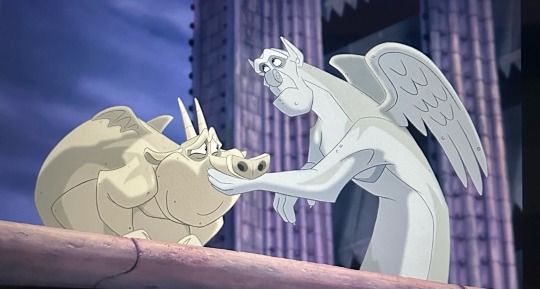
In our first real introduction to Quasimodo, we see him taking care of a baby bird and encouraging it to fly. Right away, we get a sense of his gentleness and how receptive he is to the needs of others. Quasi has a wonderful capacity for compassion, and I think that Victor’s sensitivity and emotional alertness is a reflection of this part of Quasimodo. Quasimodo is so inherently selfless that he takes care of others with no expectation of reciprocity—he genuinely just wants to help.
There’s something especially heartbreaking about the gentle and caring way that Quasimodo treats the bird, when he himself has never known that kind of love. Like, he’s giving to others what he wishes he had. This is further emphasized when Laverne echoes his own words to the baby bird, “No one wants to stay cooped up here forever.”
I also believe that Victor is representative of Quasimodo’s strong desire to know more about other people, their lives, their traditions, and their culture. When encouraging Quasimodo to go the Feast of Fools, he suggests “you could learn to identify various regional cheeses!” and “study indigenous folk music.” He places emphasis on the learning value of joining the festival, saying, “It would be a veritable potpourri of educational experience.” (side note: I love the pope pun here haha, combined with the little wooden figure)

In “A Guy Like You,” he has strong ties to cultural icons like the statue of David (at least, I think that’s what the animators are parodying here) and he wears a bow tie as he plays the grand piano by candlelight as Laverne sings.
Interpreting Victor as an imaginary friend, reflecting the traits of Quasimodo’s mind, it feels natural that Quasi also appreciates art and music. He loves human expression. He wants to connect with other people and understand how their minds work, how they explore their feelings and beliefs through their creations.
(also, on the part with the statue, I want to point out Victor timidly peeking after he covers the statue’s member. In some ways, I feel like this is a parallel of Quasimodo’s own bashful nature)

(also, in “A Guy Like You,” when Hugo says “You’ve got a look, that’s all your own, kid,” he does a picture-frame gesture towards Quasimodo with his hands/hooves, and Quasimodo draws back slightly and raises up his own hand in a gentle protest, again showing his shyness and reluctance to draw attention to himself)

Anyway, back to the point about appreciating art and culture—we see Quasimodo expressing his own artistry, creativity, and self-expression through his wooden figurines. Constructing these figures and imagining himself among the people really demonstrates his potential for empathy and his desire for connection. With his figurines, he lives vicariously through this miniature model of the city, desperately seeking out that kind of companionship and longing to join the Parisians.
In “Out There,” he wistfully sings, “All my life I memorize their faces / Knowing them as they will never know me” and he expresses a powerful desire to connect with them. He is deeply interested in their lives, their interests, and their personalities, saying how he is “Hungry for the histories they show me” and taking a curious, compassionate interest in them.

Quasimodo has a wonderful capacity for creation. When he shows Esmeralda around the bell tower, she marvels at the decoration and asks, “Did you make all these things yourself?” and Quasi softly replies, “Most of them.” He’s very humble in his response, and he hides behind a pillar as he says this line, again not wanting to draw attention to himself. Even around Esmeralda, the person who, at this point, has shown him the most kindness out of anyone, he feels really self-conscious and he is reluctant to step out into view.
Part of it might be his crush on Esmeralda and the ensuing nervousness, but I definitely think that he is also acting this way because of how Frollo raised him, constantly repeating the idea that he is a “monster” and really damaging his self-esteem. He only runs out from behind the pillar in a flustered panic when Esmeralda pulls the cover off of his unfinished wooden figures. But as he gets more comfortable around her, he introduces her to the bells and leads the way.
He cares deeply for Esmeralda—his feelings for her are compassionate and pure. This makes it all the more stressful for him when he fears she might be in danger, especially while seeing Paris burn and not knowing her whereabouts.
As the gargoyles look out, Victor frets, “I’m beginning to fear the worst” and he tries his best to be “stone-faced” when Quasimodo walks in, not wanting to upset him any further. He’s also the first to crack under pressure and and burst into a very emotional, tearful display when Quasimodo asks, “Is there any sign of her?”

Although Quasimodo is not crying in this scene, I feel like Victor is a representation of his most extreme inner feelings at the moment—catastrophizing the situation and harboring fears for Esmeralda. He genuinely just cares about her that much, and he knows that he would be devastated if anything bad happened to her.
Quasimodo shows himself to be a deeply emotional person, and cries the most out of any character in the film��crying with joy when he is crowned the King of Fools, crying with sorrow and humiliation when the crowd tortures him, crying with heartbreak when he sees Esmeralda and Phoebus kiss, and crying with grief when he believes that Esmeralda is dead. He feels with his entire heart, loving fiercely and experiencing the world with very powerful emotions. And I think that’s a really beautiful quality about him. His sensitivity is part of what makes him so strong. And his empathy for other people is the emotional core of “Out There,” his desire to live among society and know them, to find community.
Seeking companionship and love, he makes up the gargoyles as imaginary friends in his mind. By extension, he imbues them with some of his own personality traits. Victor as an imaginary friend reflects Quasimodo’s sensitivity, artistry, shyness, empathy, and emotional nature :)
26 notes
·
View notes
Text

Xochipilli : The Flower Prince
Xochipilli, alternatively recognized as the ‘Flower Prince,’ holds a prominent role in Aztec mythology. As the deity presiding over art, games, dance, flowers, and song, he represents a departure from the stern and often bloodthirsty nature of his divine counterparts. His name derives from the Nahuatl words xōchitl (“flower”) and pilli (interpreted as either “prince” or “child”), thus encapsulating the essence of “flower prince.” In contrast to his more severe peers, Xochipilli’s dominion extends to realms characterized by laughter, music, and the intoxicating pleasures inherent in the tapestry of life.
Physical Traits
Xochipilli is frequently portrayed as a youthful figure adorned in distinctive regalia. His headdress, crafted from feathers, graces his head, and he is often depicted donning a mask while enveloped in flowers sourced from psychotropic plants and hallucinogenic mushrooms. Notably, he wears a talisman called an oyohualli, a teardrop-shaped pendant fashioned from mother-of-pearl. The vibrant imagery continues with his face painted in a radiant yellow hue, symbolizing the golden sun and the vibrancy of life.
Around his neck, Xochipilli wears a necklace fashioned from shells and jade, symbolically representing both the earthly bounty and the abundance of aquatic realms. Atop his head, a feathered headdress takes center stage, adorned with bells that resonate with each movement, echoing the joyful melodies he is associated with. However, perhaps his most distinctive feature is a wide, mischievous grin, reflecting his playful nature and deep affinity for life’s pleasures.
The iconography surrounding Xochipilli accentuates his strong association with pleasure and euphoria. Depictions of the deity often showcase him with a joyous countenance, engaging in activities such as playing musical instruments or participating in dance. This visual narrative underscores his pivotal role as a patron of the arts and revelry, symbolizing the exuberant celebration of life’s myriad joys.
Powers and Abilities
Xochipilli’s influence extends far beyond the realm of brute force, manifesting in the enchantment he effortlessly weaves through his touch. Possessing the remarkable ability to kindle creativity, spark passion, and infuse hearts with unbridled joy, he governs the intoxicating realms of art, music, and dance. In his presence, mortals find themselves transported to dimensions of ecstatic bliss, captivated by the alluring magic he bestows.
Central to Xochipilli’s dominion is his unique connection to flowers and hallucinogenic plants, granting him the power to unlock concealed pathways of perception. In doing so, he reveals profound truths and inner landscapes, broadening the horizons of those touched by his divine influence. With a mischievous playfulness, Xochipilli possesses the ability to conjure laughter and dissolve tensions through lighthearted pranks. His true strength lies in the profound reminder he offers – that beauty and joy are inherent in every fleeting moment of life.
Revered as one of the Ahuiateteo, gods of excess, Xochipilli’s domain transcends mere mortal desires. He is intimately tied to dance, painting, creativity, and festivities, embodying the essence of indulgence. Xochipilli’s profound connection to the souls, fertility, and the abundance of nature symbolizes the intricate interdependence of life’s myriad facets. As a bestower of fertility, he oversees the procreation of new life and the flourishing growth of abundance, weaving a tapestry of vitality and interconnectedness within the fabric of existence.
Xochipilli by Talon Abraxas
10 notes
·
View notes
Note
pls talk about ginger snaps i love hearing peoples thoughts on it, i am so mentally ill about this movie ;;;
LET'S GOOOO ok so i have so so so so so much to say
1.) one of the ways ginger snaps really succeeded for me in the way that some of the ways that other movies about the horrors of puberty and womanhood is that it's really willing to commit to the concept of the "benefits" (being perceived as desirable) are only barely masking terrible effects that make her cry in her sister's arms. many other movies of this genre just throw some blood and sharp teeth on a gal and call it a day but ginger snaps has a lot to say about how puberty is inherently horrifying. "i can't have chest hair, B, that's FUCKED" and the taping the tail to her leg being my favorite examples. The dichotomy of thrashing violently between trying to own it and have fun with it and being like "oh my god this is fucking horrible i'm having a mental breakdown"
Spoilerssss under the cut
2.) throughout the third act is a prevalent sense of "we almost made it" because the ideas these characters have are genuinely good ideas and the timing just gets fucked all to hell. I also love the detail that Brigitte kills her sister not as an act of self preservation but simply because she flinched with the wrong hand 3.) i love how layered the foreshadowing is throughout the movie. Nothing comes out of left field the whole movie! I love how mimi rogers does arts and crafts and is always surrounded by flowers and then when Brigitte obtains monkshood it's believable! i love when movies are creative enough to avoid falling into the deus ex machina trap! 4.) this movie has like really really lovely things to say about 5.) i love when horror movies are willing to examine the tragedy of all. So many slashers fall into the trap of being so focused on having a triumphant final girl moment at the end that they forget to express mourning and grief which is imo the best part of any good horror movie. When Brigette hills her sister it's not really a win, and she ends the movies in tears with her dying sister in her arms.
6.) on that note the codependency of a close sibling relationship is probably what sells the movie the most to me. "I'm furious with you and you're my nemesis right now but I would die for you is SO REAL. 7.) my favorite scene in THE whole movie is after ginger kills the popular girl when the parents get home and they just act like it's one of their staged death photos (ties back to the foreshadowing thing i was talking about earlier) I love when horror characters are smart and resourceful and creative.
8.) did you know there's no cgi in the whole movie not even touch up cgi it's ALL PRACTICAL EFFECTS AND MOST OF THEM STILL LOOK GOOD EVEN TODAY
9.) i love that they put the werewolf transformation in the back of a moving vehicle in the dark? muah muah muah muah
10.) every character feels thought through and well developed even if they don't really have a lot of screentime. like ginger snaps is a fairly melodramatic movie but they manage to feel like people through all of that the bully the mom etc
There's more but that's off thje top of my head :)
#Hi I know yo sent this like a week ago. I was in phoenix.#ginger snaps#ginger fitzgerald#horror#slimed and answered#monster growl
6 notes
·
View notes
Text
The Healing process of Chiron in Taurus in each house

Chiron in Taurus is associated with wounds related to self-worth, values, and material possessions. These wounds can manifest differently depending on which house Chiron is placed in within an individual's natal chart.
Remember that healing Chiron in Taurus is a process of reconnecting with your intrinsic self-worth and values. It involves learning to appreciate your unique qualities and finding stability within yourself, regardless of external circumstances.
Chiron in Taurus in 1st house: Your wound centers on self-esteem and self-image. To heal, prioritize building a strong sense of self-worth that doesn't rely solely on external validation. Recognize and celebrate your natural talents and unique qualities. Engaging in self-care routines, such as massages or skincare, can boost your confidence and reinforce your self-value.
Chiron in Taurus in 2nd house: Wounds are often related to finances, possessions, and self-value. Healing requires reevaluating your relationship with money and material possessions. Learn financial literacy to manage your resources wisely. Cultivate a sense of abundance beyond material wealth, finding value in your skills, talents, and personal worth.
Chiron in Taurus in 3rd house: Your wounds may be tied to communication and learning. To heal, focus on developing assertive yet grounded communication skills. Find your voice and express your thoughts calmly and confidently. Explore your talents in writing, art, or music as therapeutic outlets for self-expression.
Chiron in Taurus in 4th house: Family and home-related issues can trigger wounds. Healing involves creating a secure and stable home environment. Embrace your own values. Work on developing a sense of inner security that isn't solely dependent on external circumstances. Address any past family issues with patience and understanding.
Chiron in Taurus in 5th house: Wounds may revolve around self-expression, creativity, and personal passions. To heal, immerse yourself in artistic pursuits that allow you to express your unique values and talents. Embrace your creativity and take pride in your hobbies and interests. Value your individuality, your expression, your tastes. Don't be afraid to be who you are. Value who you are. Explore your romantic and playful side, valuing yourself as an inherently unique individual.
Chiron in Taurus in 6th house: Health and work-related issues may be sources of pain. Healing involves taking care of your physical well-being through a balanced routine and self-care practices. In your work, assert your value and seek employment that aligns with your core values. Avoid overworking yourself; find a sustainable work-life balance.
Chiron in Taurus in 7th house: Relationships and partnerships may trigger wounds. Healing includes recognizing your self-worth and setting clear boundaries in your relationships. Seek partners who value you for who you are and appreciate your unique qualities. Cultivate a sense of stability and security within partnerships without sacrificing your individuality.
Chiron in Taurus in 8th house: Wounds may relate to shared resources, intimacy, and trust. To heal, address any financial insecurities by gaining knowledge about joint finances and investments. Work on building trust in intimate relationships, allowing yourself to be vulnerable without fear of losing your self-worth. Understand that emotional depth can be a source of strength.
Chiron in Taurus in 9th house: Beliefs and higher education can be sources of wounds. Healing involves exploring your values and beliefs on a deeper level. Engage in philosophical or spiritual practices that align with your core values. Embrace a practical approach to expanding your horizons through travel and education, focusing on personal growth.
Chiron in Taurus in 10th house: Career and public image may trigger pain. To heal, concentrate on finding a career path that aligns with your values and talents. Cultivate a strong professional image that reflects your self-worth and integrity. Don't shy away from asserting your value and advocating for your contributions in the workplace.
Chiron in Taurus in 11th house: Wounds may relate to friendships and social circles. Healing includes finding friends who share your values and appreciate your unique qualities. Cultivate a sense of stability within group dynamics. Use your practicality to contribute positively to causes that matter to you, ensuring your individuality shines within the collective.
Chiron in Taurus in 12th house: Spirituality, secrets, and the subconscious can be sources of wounds. Healing involves exploring your inner world and hidden aspects of your psyche. Embrace your spiritual path in a grounded and practical way, integrating it into your daily life. Trust your intuition to navigate the depths of your subconscious while valuing your spiritual journey as a core part of your identity. Learn to appreciate the wisdom that comes from the unseen realms.
#chiron in taurus#taurus chiron#chiron in taurus in the houses#healing process#healing chiron#astrology of healing#astrology#chiron
8 notes
·
View notes